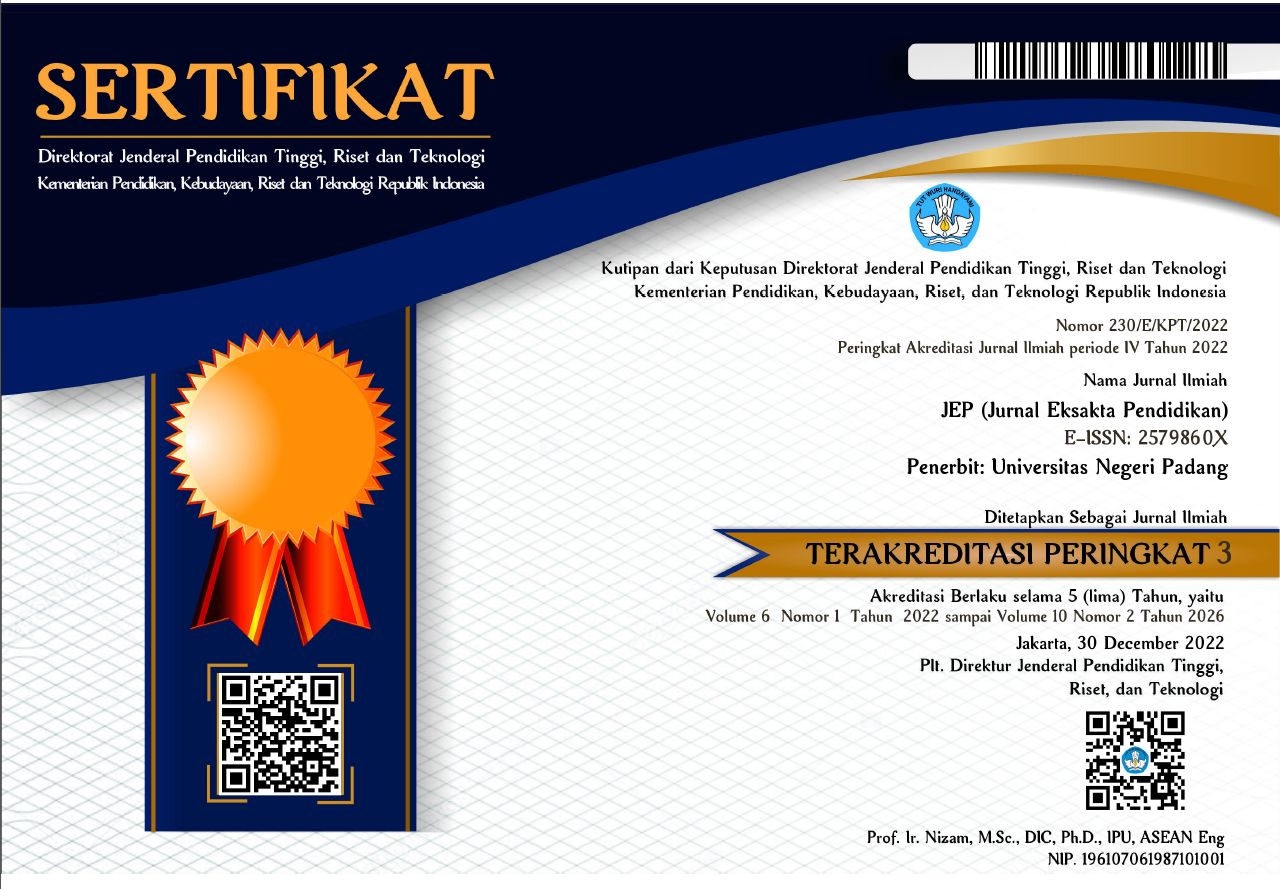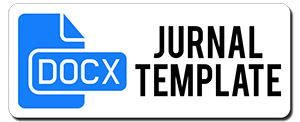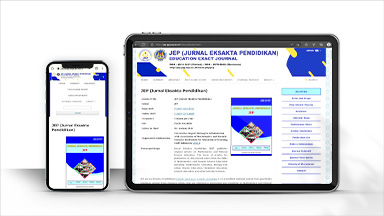Penerapan Strategi Flipped Classroom dengan Pendekatan Scientific dalam Pembelajaran Matematika pada Kelas XI SMKN 2 Padang Panjang
Abstract
The issues in this study are how learning outcomes, learning motivation and student’s interest in mathematics learning material are being affected after applying classroom flipped learning strategies with a scientific approach to class XI grade students of SMK 2 Padangpanjang? Are student’s learning outcomes by applying classroom flipped strategies with the scientific approach are better than the one that does not apply that method? This study aims to describe student’s learning outcomes, motivation, and interests in mathematics learning, and to see whether the experimental class learning outcomes are better than the control class. This research was conducted at SMK 2 Padang Panjang in the academic year 2017/2018. The sample is taken by using the random sampling technique which consisted of two sample groups, and each is consisted of 28 people. Based on the results of the study, it can be concluded that the student’s mathematics learning outcomes are better than the previous one. In addition, student’s motivation towards mathematics learning is in a high level and students' interests as well.
Downloads
References
Adhitiya, E N, A Prabowo, and R Arifudin. 2015. “Studi Komparasi Model Pembelajaran Traditional Flipped Dengan Peer Instruction Flipped Terhadap Kemampuan Pemecahan Masalah.” Unnes Journal of Mathematics Education 4(2): hal. 17–26.
Arikunto, Suharismi. 2013. Dasar – Dasar Evaluasi Pendidikan”. Jakarta : Bumi Aksara.
Arikunto, Suharismi. 2010. Prosedur Penelitian. Yogyakarta: Rineka Cipta.
Baepler, P., Walker, J. D., & Driessen, M. 2014. It’s not about seat time: Blending, flipping, and efficiency in active learning classrooms. Computers & Education, 78, 227–236. https://doi.org/10.1016/j.compedu.2014.06.006.
Bell, M. R. 2015. An investigation of the impact of a flipped classroom instructional approach on high school students’ content knowledge and attitudes toward the learning environment. Unpublished master thesis, Brigham Young University, Utah.
Bishop, J. L., & Verleger, M. A. 2013. The flipped classroom: A survey of the research. In ASEE National Conference Proceedings, Atlanta, GA (Vol. 30, No. 9, pp. 1–18).
Bonwell, C. C., & Eison, J. A. 1991. Active Learning: Creating Excitement in the Classroom. ASHE-ERIC Higher Education Report No. 1. Washington D.C.: The George Washington University, School of Education and Human Development.Bolat, Y. 2016. The flipped classes and education information network (EIN). Journal of Human Sciences, 13 (2), 3373-3388.
Çakır, E. 2017. The effect of flipped classroom on 7th grade students’ academic achievemnt, cognitive risk taking skills and computational thinking skills in science education classroom. Unpublished master thesis, On Dokuz Mayıs University, Samsun.
Cheng, Y., & Weng, C. 2017. Factors influence the digital media teaching of primary school teachers in a flipped class: A Taiwan case study. South African Journal of Education, 37(1), 1–12.
https://doi.org/10.15700/saje.v37n1a1293.
Cortese, A. D. 2003. The critical role of higher education in creating a sustainable future. Planning for Higher Education, 31(3), 15–22.
Daryanto. 2014. Pendekatan Pembelajaran Saintifik Kurikulum 2013. Yogyakarta: Gava Media.
Dewi, N.L., Dantes, N.,&Sadia,I.W. 2013. Pengaruh Model Pembelajaran Inkuiri terbimbing terhadap sikap Ilmiah dan Hasil Belajar IPA. Pendasi: Jurnal Pendidikan Dasar Indonesia, 3(1).
Dimyati dan Mudjiono. 2006 “Belajar dan Pembelajaran”. Jakarta : PT. Rineka Cipta.
Fulton, K. 2012. Upside down and inside out: Flip your classroom to improve student learning. Learning & Leading with Technology, 39(8), 12–17.
Hamdani. 2011. Strategi Belajar Mengajar. Bandung : Pustaka Setia.
Haryanti, Francisca. 2016. Peran Teknologi Dalam Flipped Classroom”. Dinama Teknologi 16 Vol 8.
Herron, J.D., Luis, L., Cantu, Richard, W., & Venu, S. (1977). Problems Associated with Concept Analysis. Science Education, 61(2), 185-199.
Huereca, K. 2015. High school mathematics teachers’ connective knowledge of the challenges and possibilities in implementing the flipped learning model: An embedded mixed-methods study. Published dissertation: The University of Texas at El Paso.
Janssen, Fred J. J. M., Hanna B. Westbroek and Jan H. van Driel. (2014). How to Make Guided Discovery Learning Practical for Student Teachers. Instr Sci, 42,67–90.
Jeong, J. S., González-Gómez, D., & Cañada-Cañada, F. (2016). Students’ perceptions and emotions toward learning in a flipped general science classroom. Journal of Science Education and Technology, 25(5), 747–758. https://doi.org/10.1007/s10956-016-9630-8.
Kemendikbud. 2016. Silabus Mata Pelajaran Sekolah Menengah Atas/Madrasah Aliyah (SMA/MA) Mata Pelajaran Matematika. Jakarta: Kementrian Pendidikan dan Kebudayaan.
Kemendikbud. 2014. Implementasi Kurikulum 2013 Mata Pelajaran Matematika SMP/MTs”. Jakarta: Kemendikbud.
Misseyanni, A., Lytras, M. D., Papadopoulou, P., & Marouli, C. (2018). Introduction. In A. Misseyanni, M. D. Lytras, P. Papadopoulou, & C. Marouli (Eds.), Active Learning Strategies in Higher Education: Teaching for Leadership, Innovation, and Creativity, (pp. 1–13). United Kingdom: Emerald Publishing Limited.
Nur Fitriyana Ulfa, Budi Murtiyasa. 2014. Implementasi Strategi Flipped classroom Dalam Pembelajaran Matematika Terhadap Kemampuan Kognitif Ditinjau Dari Keaktifan Belajar Peserta didik SMA Negeri 1 Surakarta”.
O’Flaherty, J., & Phillips, C. 2015. The use of flipped classrooms in higher education: A scoping review. Internet and Higher Education, 25, 85–95.
https://doi.org/10.1016/j.iheduc.2015.02.002.
Roehl, A., Reddy, S. H., & Shannon, G. J. (2013). The flipped classroom: An opportunity to engage millennial students through active learning strategies. Journal of Family and Consumer Sciences, 105(2), 44–49.
Roth, K. 2014. Elementary science teaching. In N. Lederman, & S. Abell (Eds.), Handbook of research on science education, (vol. 2, pp. 361–394). New York: Routledge.
Sudjana, Nana. 2013. Penilaian Hasil Proses Belajar Mengajar. Bandung: PT Remaja Rosdakarya.
Sudjana. 2005. Metode Statistik. Bandung: PT. Tarsito.
Sugiyono. 2007. "Metode Penelitian Pendidikan". Bandung: Alfabeta.
Suryabrata, Sumadi. 2011. "Metodologi Penelitian". Yogyakarta: PT. Raja Grafindo Persada.
Suyahya, Indra. 2014. Efektifitas Pelaksanaan Strategi Pembelajaran Flipped classroom Dengan Memanfaatkan Media Pembelajaran Software Pesona Edu Dalam Meningkatkan Prestasi Belajar Sisiwa Di SMP Jakarta.” Seminar Nasional Hasil-hasil Penelitian (20): 86–92.
Talbert, R. 2017. Flipped learning: A guide for higher education faculty. Virginia: Stylus Publishing.
Vaughan, M. 2014. Flipping the learning: An investigation into the use of the flipped classroom model in an introductory teaching course. Education Research and Perspectives (Online), 41, 25.
Wals, A. E., & Jickling, B. 2002. “Sustainability” in higher education: From doublethink and newspeak to critical thinking and meaningful learning. International Journal of Sustainability in Higher Education, 3(3), 221–232. https://doi.org/10.1108/14676370210434688.
Zainuddin, Z. & Halili, S. H. 2016. Flipped classroom research and trends from different fields of study. International Review of Research in Open and Distributed Learning, 17 (3), 313-340.
Copyright (c) 2019 Dr. Usmadi, M.Pd madi madi, Ergusni Ergusni

This work is licensed under a Creative Commons Attribution 4.0 International License.

This work is licensed under a Creative Commons Attribution 4.0 International License.




_(2579-860X).png)
_(2614-1221)1.png)




